Obafemi Awolowo University: Lassa Fever Case Study, Public Health
VerifiedAdded on 2022/04/12
|39
|6112
|36
Case Study
AI Summary
This case study presents a detailed analysis of a 12-year-old boy diagnosed with Lassa Fever in Lagos State, Nigeria. The study, conducted by a student in the Public Health Programme at Obafemi Awolowo University, covers the patient's personal and medical history, including presenting symptoms such as fever, vomiting, diarrhea, and bleeding. It delves into the diagnostic process, investigations, and management strategies employed, referencing relevant literature on Lassa Fever's causative agent, mode of transmission, incubation period, clinical manifestations, and public health interventions. The case study also includes a literature review, objectives, and recommendations, offering a comprehensive understanding of the disease and its management within a public health context. The patient was admitted to the children emergency department after being referred from Mobonate Hospital Dopemu Agege to Lagos university teaching hospital Idi-Araba Lagos. The study also covers the patient's family history, social background, and the importance of public health education in preventing and controlling the spread of the disease. The case study also highlights the importance of a good relationship between the healthcare provider and the family in the management of the patient.
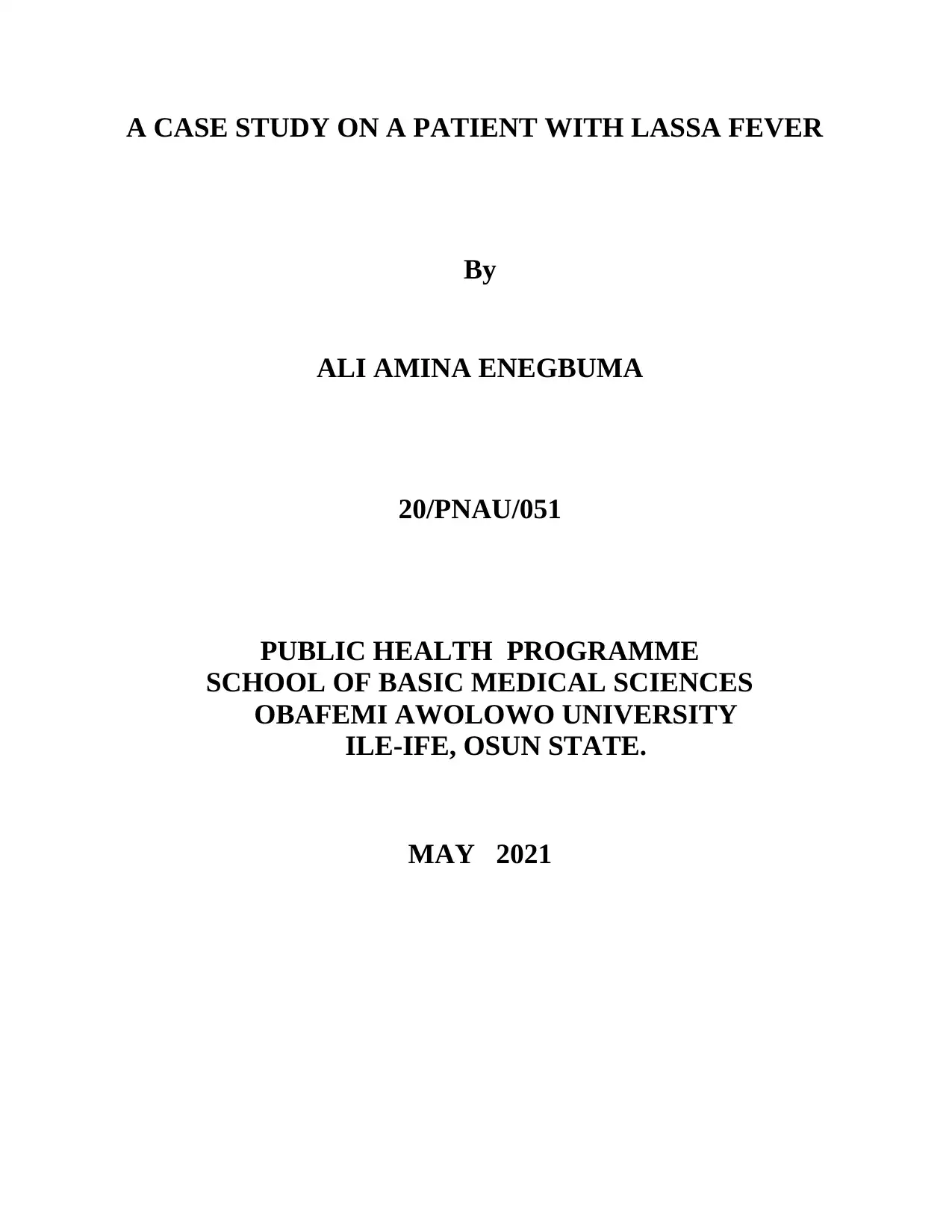
A CASE STUDY ON A PATIENT WITH LASSA FEVER
By
ALI AMINA ENEGBUMA
20/PNAU/051
PUBLIC HEALTH PROGRAMME
SCHOOL OF BASIC MEDICAL SCIENCES
OBAFEMI AWOLOWO UNIVERSITY
ILE-IFE, OSUN STATE.
MAY 2021
By
ALI AMINA ENEGBUMA
20/PNAU/051
PUBLIC HEALTH PROGRAMME
SCHOOL OF BASIC MEDICAL SCIENCES
OBAFEMI AWOLOWO UNIVERSITY
ILE-IFE, OSUN STATE.
MAY 2021
Paraphrase This Document
Need a fresh take? Get an instant paraphrase of this document with our AI Paraphraser
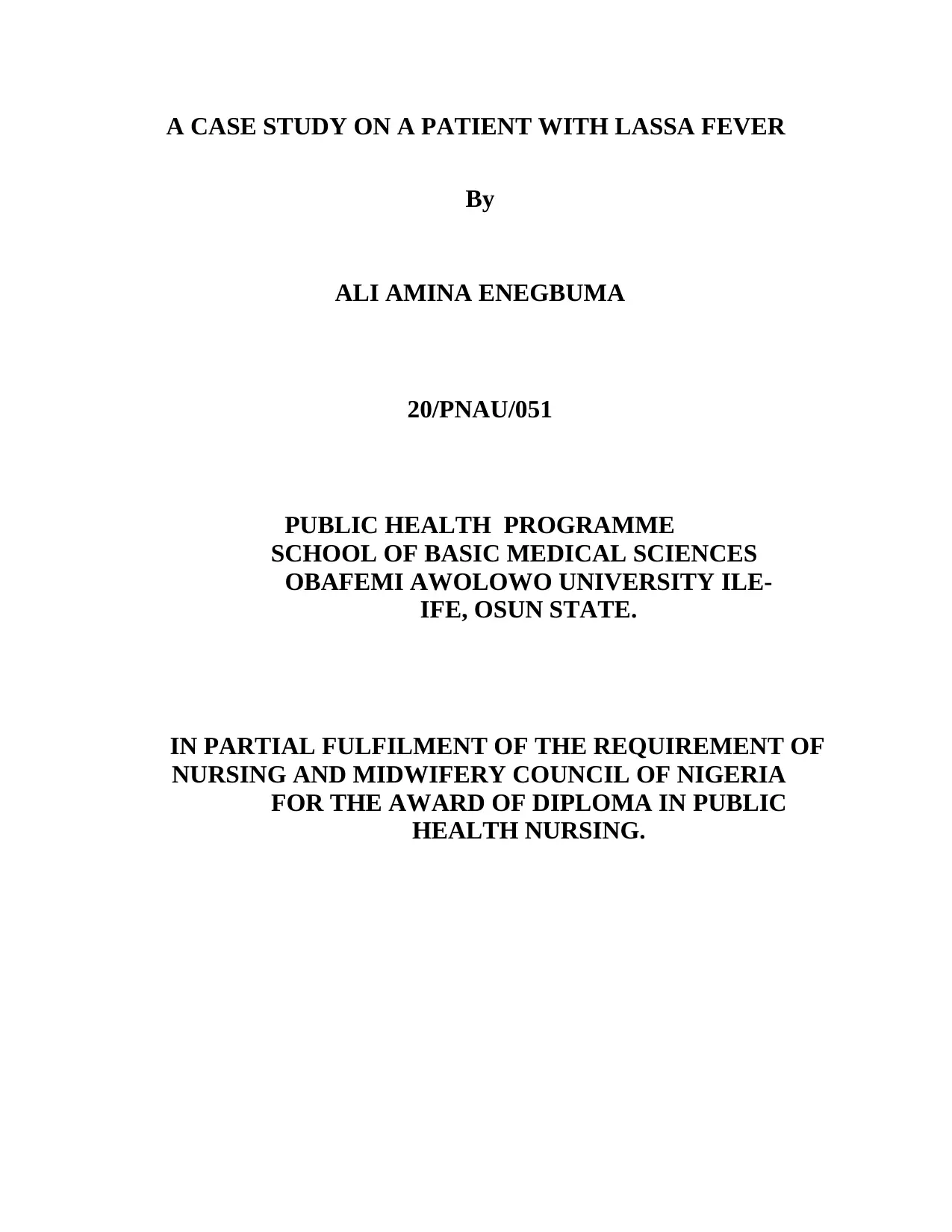
A CASE STUDY ON A PATIENT WITH LASSA FEVER
By
ALI AMINA ENEGBUMA
20/PNAU/051
PUBLIC HEALTH PROGRAMME
SCHOOL OF BASIC MEDICAL SCIENCES
OBAFEMI AWOLOWO UNIVERSITY ILE-
IFE, OSUN STATE.
IN PARTIAL FULFILMENT OF THE REQUIREMENT OF
NURSING AND MIDWIFERY COUNCIL OF NIGERIA
FOR THE AWARD OF DIPLOMA IN PUBLIC
HEALTH NURSING.
By
ALI AMINA ENEGBUMA
20/PNAU/051
PUBLIC HEALTH PROGRAMME
SCHOOL OF BASIC MEDICAL SCIENCES
OBAFEMI AWOLOWO UNIVERSITY ILE-
IFE, OSUN STATE.
IN PARTIAL FULFILMENT OF THE REQUIREMENT OF
NURSING AND MIDWIFERY COUNCIL OF NIGERIA
FOR THE AWARD OF DIPLOMA IN PUBLIC
HEALTH NURSING.
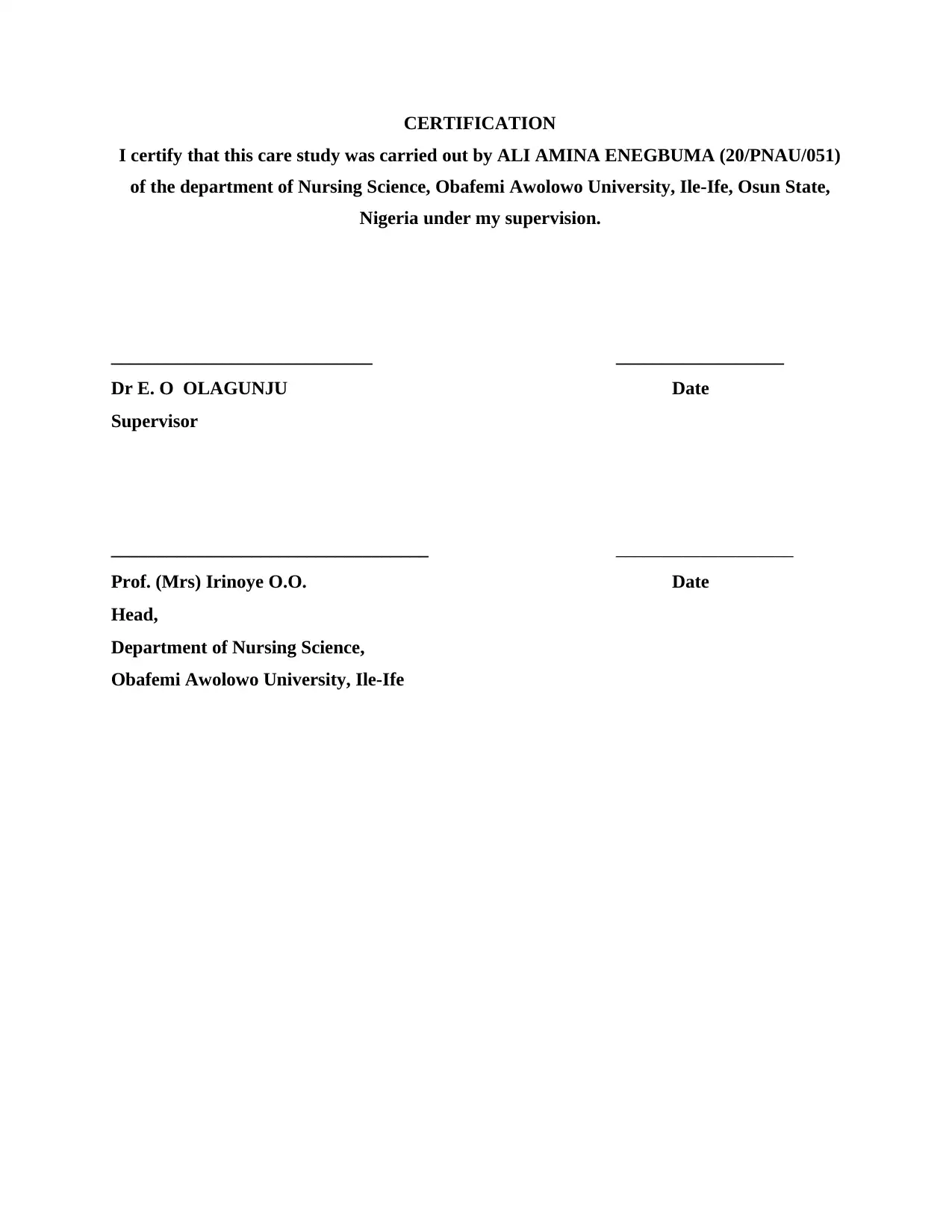
CERTIFICATION
I certify that this care study was carried out by ALI AMINA ENEGBUMA (20/PNAU/051)
of the department of Nursing Science, Obafemi Awolowo University, Ile-Ife, Osun State,
Nigeria under my supervision.
____________________________ __________________
Dr E. O OLAGUNJU Date
Supervisor
__________________________________ ___________________
Prof. (Mrs) Irinoye O.O. Date
Head,
Department of Nursing Science,
Obafemi Awolowo University, Ile-Ife
I certify that this care study was carried out by ALI AMINA ENEGBUMA (20/PNAU/051)
of the department of Nursing Science, Obafemi Awolowo University, Ile-Ife, Osun State,
Nigeria under my supervision.
____________________________ __________________
Dr E. O OLAGUNJU Date
Supervisor
__________________________________ ___________________
Prof. (Mrs) Irinoye O.O. Date
Head,
Department of Nursing Science,
Obafemi Awolowo University, Ile-Ife
⊘ This is a preview!⊘
Do you want full access?
Subscribe today to unlock all pages.

Trusted by 1+ million students worldwide
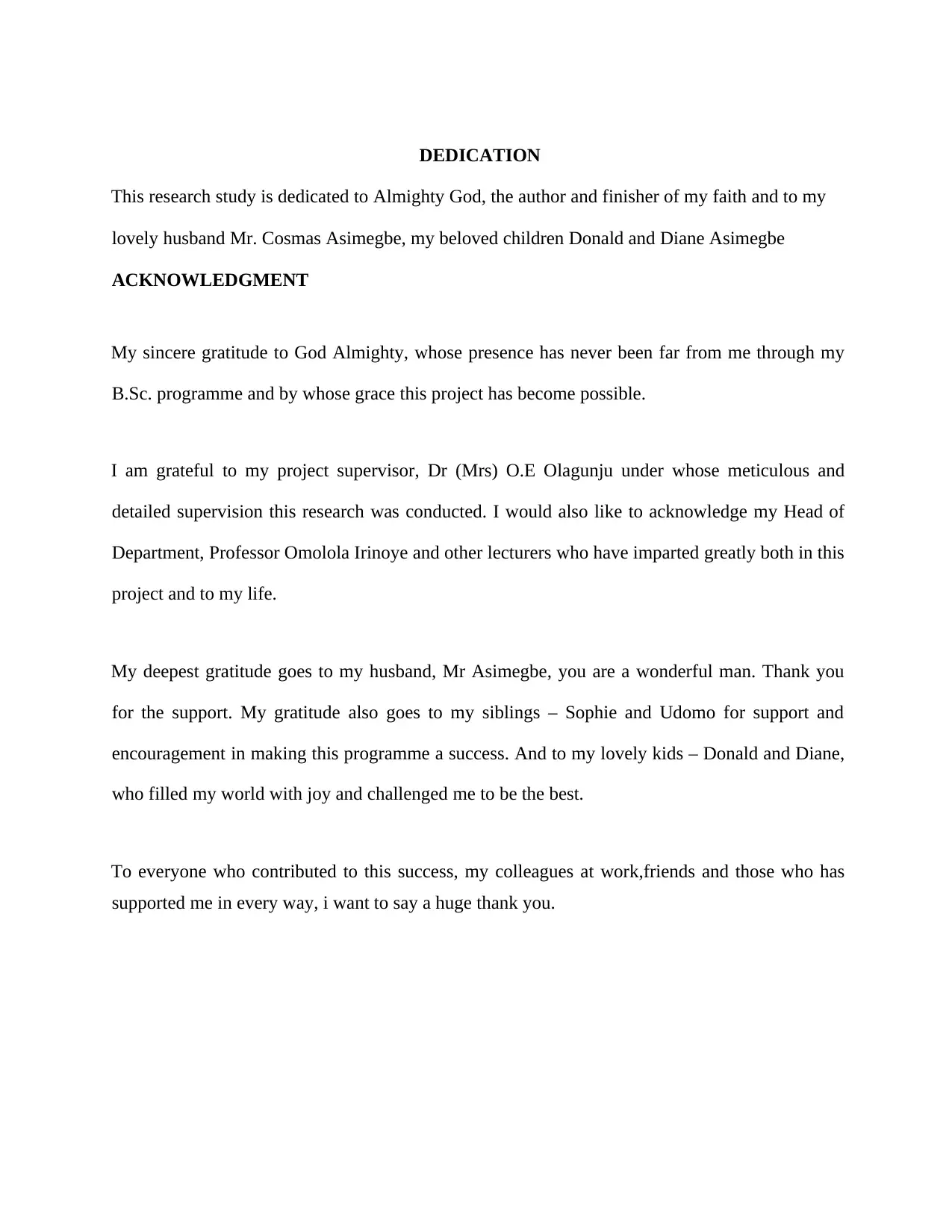
DEDICATION
This research study is dedicated to Almighty God, the author and finisher of my faith and to my
lovely husband Mr. Cosmas Asimegbe, my beloved children Donald and Diane Asimegbe
ACKNOWLEDGMENT
My sincere gratitude to God Almighty, whose presence has never been far from me through my
B.Sc. programme and by whose grace this project has become possible.
I am grateful to my project supervisor, Dr (Mrs) O.E Olagunju under whose meticulous and
detailed supervision this research was conducted. I would also like to acknowledge my Head of
Department, Professor Omolola Irinoye and other lecturers who have imparted greatly both in this
project and to my life.
My deepest gratitude goes to my husband, Mr Asimegbe, you are a wonderful man. Thank you
for the support. My gratitude also goes to my siblings – Sophie and Udomo for support and
encouragement in making this programme a success. And to my lovely kids – Donald and Diane,
who filled my world with joy and challenged me to be the best.
To everyone who contributed to this success, my colleagues at work,friends and those who has
supported me in every way, i want to say a huge thank you.
This research study is dedicated to Almighty God, the author and finisher of my faith and to my
lovely husband Mr. Cosmas Asimegbe, my beloved children Donald and Diane Asimegbe
ACKNOWLEDGMENT
My sincere gratitude to God Almighty, whose presence has never been far from me through my
B.Sc. programme and by whose grace this project has become possible.
I am grateful to my project supervisor, Dr (Mrs) O.E Olagunju under whose meticulous and
detailed supervision this research was conducted. I would also like to acknowledge my Head of
Department, Professor Omolola Irinoye and other lecturers who have imparted greatly both in this
project and to my life.
My deepest gratitude goes to my husband, Mr Asimegbe, you are a wonderful man. Thank you
for the support. My gratitude also goes to my siblings – Sophie and Udomo for support and
encouragement in making this programme a success. And to my lovely kids – Donald and Diane,
who filled my world with joy and challenged me to be the best.
To everyone who contributed to this success, my colleagues at work,friends and those who has
supported me in every way, i want to say a huge thank you.
Paraphrase This Document
Need a fresh take? Get an instant paraphrase of this document with our AI Paraphraser
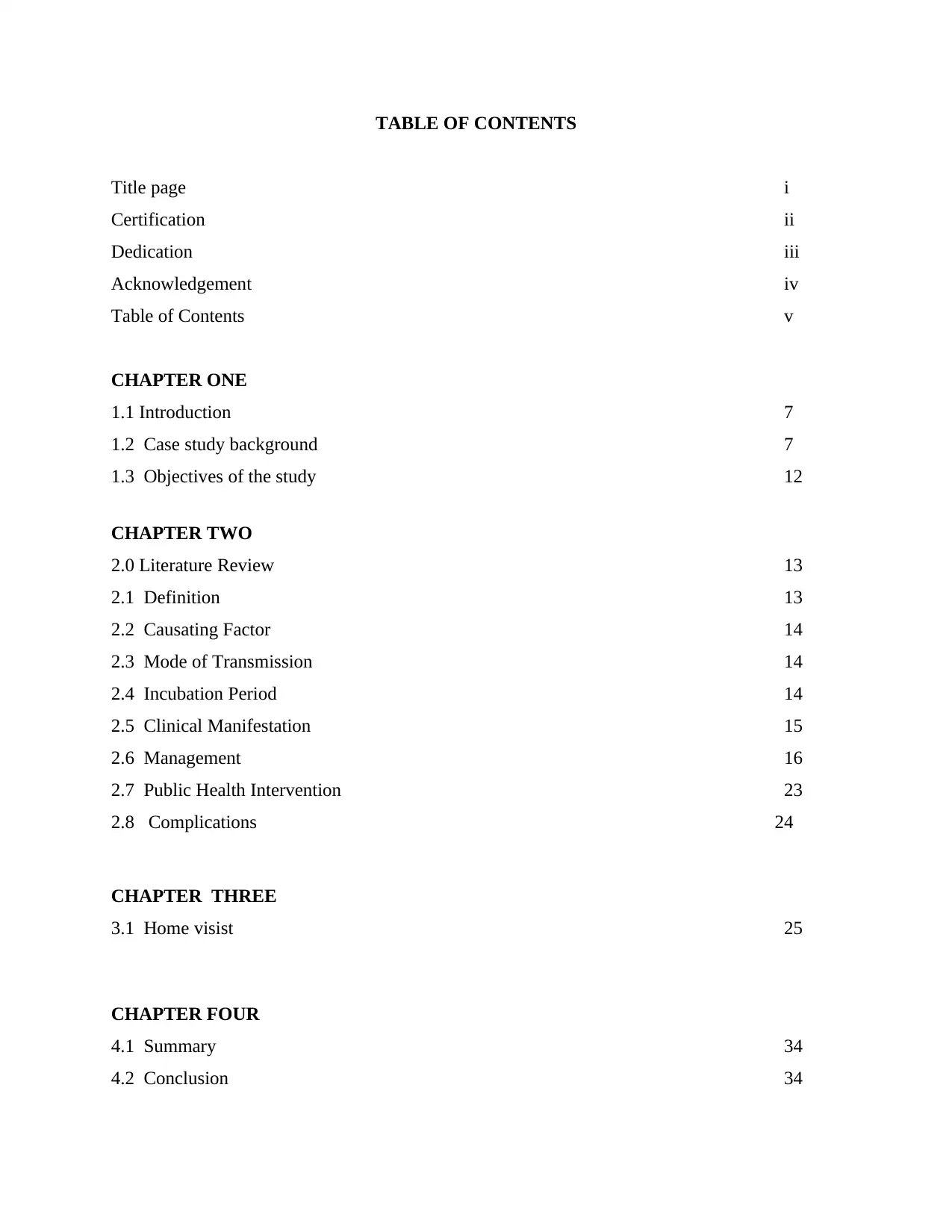
TABLE OF CONTENTS
Title page i
Certification ii
Dedication iii
Acknowledgement iv
Table of Contents v
CHAPTER ONE
1.1 Introduction 7
1.2 Case study background 7
1.3 Objectives of the study 12
CHAPTER TWO
2.0 Literature Review 13
2.1 Definition 13
2.2 Causating Factor 14
2.3 Mode of Transmission 14
2.4 Incubation Period 14
2.5 Clinical Manifestation 15
2.6 Management 16
2.7 Public Health Intervention 23
2.8 Complications 24
CHAPTER THREE
3.1 Home visist 25
CHAPTER FOUR
4.1 Summary 34
4.2 Conclusion 34
Title page i
Certification ii
Dedication iii
Acknowledgement iv
Table of Contents v
CHAPTER ONE
1.1 Introduction 7
1.2 Case study background 7
1.3 Objectives of the study 12
CHAPTER TWO
2.0 Literature Review 13
2.1 Definition 13
2.2 Causating Factor 14
2.3 Mode of Transmission 14
2.4 Incubation Period 14
2.5 Clinical Manifestation 15
2.6 Management 16
2.7 Public Health Intervention 23
2.8 Complications 24
CHAPTER THREE
3.1 Home visist 25
CHAPTER FOUR
4.1 Summary 34
4.2 Conclusion 34

4.3 Recommendation 35
4.4 Bibliography 37
4.4 Bibliography 37
⊘ This is a preview!⊘
Do you want full access?
Subscribe today to unlock all pages.

Trusted by 1+ million students worldwide
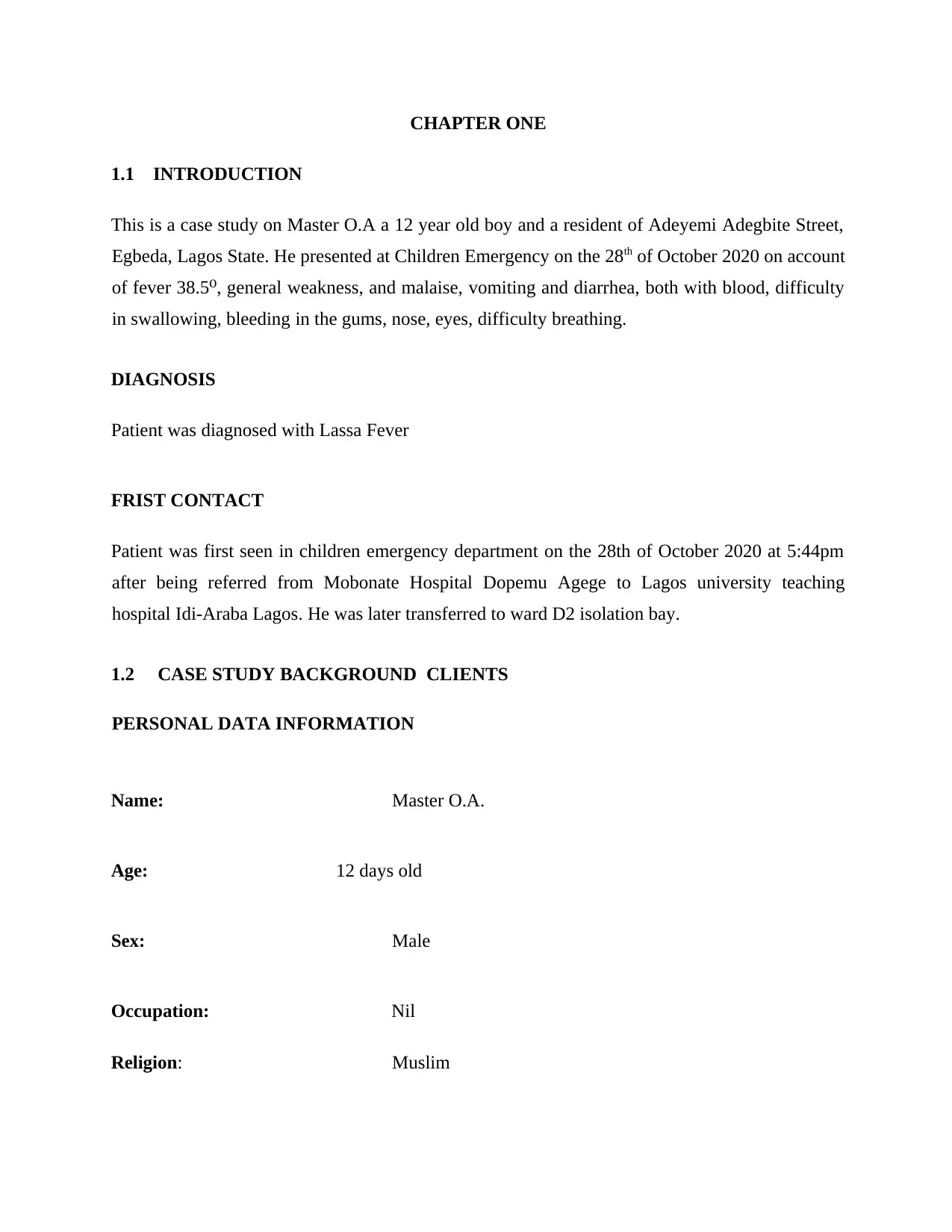
CHAPTER ONE
1.1 INTRODUCTION
This is a case study on Master O.A a 12 year old boy and a resident of Adeyemi Adegbite Street,
Egbeda, Lagos State. He presented at Children Emergency on the 28th of October 2020 on account
of fever 38.5 , general weakness, and malaise, vomiting and diarrhea, both with blood, difficulty⁰
in swallowing, bleeding in the gums, nose, eyes, difficulty breathing.
DIAGNOSIS
Patient was diagnosed with Lassa Fever
FRIST CONTACT
Patient was first seen in children emergency department on the 28th of October 2020 at 5:44pm
after being referred from Mobonate Hospital Dopemu Agege to Lagos university teaching
hospital Idi-Araba Lagos. He was later transferred to ward D2 isolation bay.
1.2 CASE STUDY BACKGROUND CLIENTS
PERSONAL DATA INFORMATION
Name: Master O.A.
Age: 12 days old
Sex: Male
Occupation: Nil
Religion: Muslim
1.1 INTRODUCTION
This is a case study on Master O.A a 12 year old boy and a resident of Adeyemi Adegbite Street,
Egbeda, Lagos State. He presented at Children Emergency on the 28th of October 2020 on account
of fever 38.5 , general weakness, and malaise, vomiting and diarrhea, both with blood, difficulty⁰
in swallowing, bleeding in the gums, nose, eyes, difficulty breathing.
DIAGNOSIS
Patient was diagnosed with Lassa Fever
FRIST CONTACT
Patient was first seen in children emergency department on the 28th of October 2020 at 5:44pm
after being referred from Mobonate Hospital Dopemu Agege to Lagos university teaching
hospital Idi-Araba Lagos. He was later transferred to ward D2 isolation bay.
1.2 CASE STUDY BACKGROUND CLIENTS
PERSONAL DATA INFORMATION
Name: Master O.A.
Age: 12 days old
Sex: Male
Occupation: Nil
Religion: Muslim
Paraphrase This Document
Need a fresh take? Get an instant paraphrase of this document with our AI Paraphraser
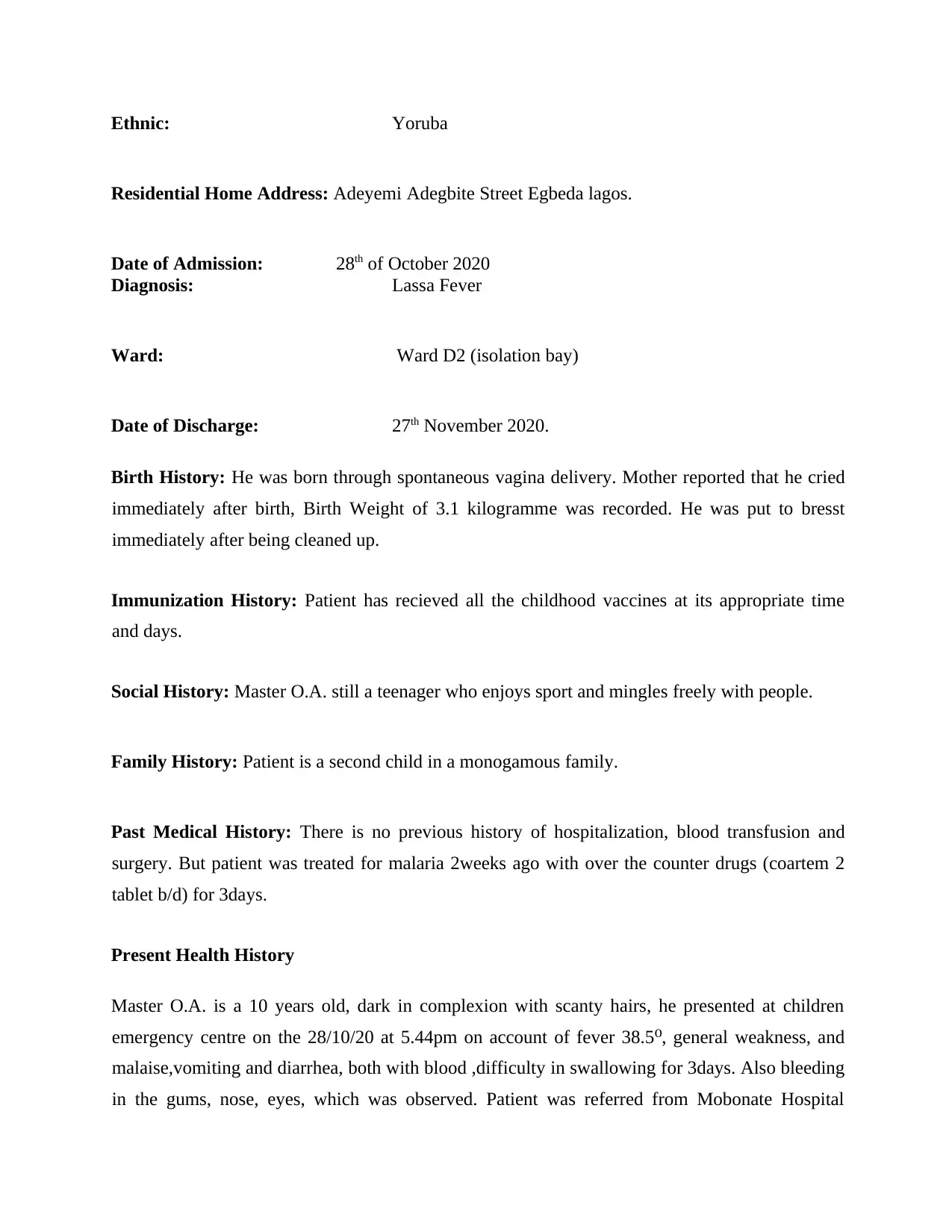
Ethnic: Yoruba
Residential Home Address: Adeyemi Adegbite Street Egbeda lagos.
Date of Admission: 28th of October 2020
Diagnosis: Lassa Fever
Ward: Ward D2 (isolation bay)
Date of Discharge: 27th November 2020.
Birth History: He was born through spontaneous vagina delivery. Mother reported that he cried
immediately after birth, Birth Weight of 3.1 kilogramme was recorded. He was put to bresst
immediately after being cleaned up.
Immunization History: Patient has recieved all the childhood vaccines at its appropriate time
and days.
Social History: Master O.A. still a teenager who enjoys sport and mingles freely with people.
Family History: Patient is a second child in a monogamous family.
Past Medical History: There is no previous history of hospitalization, blood transfusion and
surgery. But patient was treated for malaria 2weeks ago with over the counter drugs (coartem 2
tablet b/d) for 3days.
Present Health History
Master O.A. is a 10 years old, dark in complexion with scanty hairs, he presented at children
emergency centre on the 28/10/20 at 5.44pm on account of fever 38.5 , general weakness, and⁰
malaise,vomiting and diarrhea, both with blood ,difficulty in swallowing for 3days. Also bleeding
in the gums, nose, eyes, which was observed. Patient was referred from Mobonate Hospital
Residential Home Address: Adeyemi Adegbite Street Egbeda lagos.
Date of Admission: 28th of October 2020
Diagnosis: Lassa Fever
Ward: Ward D2 (isolation bay)
Date of Discharge: 27th November 2020.
Birth History: He was born through spontaneous vagina delivery. Mother reported that he cried
immediately after birth, Birth Weight of 3.1 kilogramme was recorded. He was put to bresst
immediately after being cleaned up.
Immunization History: Patient has recieved all the childhood vaccines at its appropriate time
and days.
Social History: Master O.A. still a teenager who enjoys sport and mingles freely with people.
Family History: Patient is a second child in a monogamous family.
Past Medical History: There is no previous history of hospitalization, blood transfusion and
surgery. But patient was treated for malaria 2weeks ago with over the counter drugs (coartem 2
tablet b/d) for 3days.
Present Health History
Master O.A. is a 10 years old, dark in complexion with scanty hairs, he presented at children
emergency centre on the 28/10/20 at 5.44pm on account of fever 38.5 , general weakness, and⁰
malaise,vomiting and diarrhea, both with blood ,difficulty in swallowing for 3days. Also bleeding
in the gums, nose, eyes, which was observed. Patient was referred from Mobonate Hospital
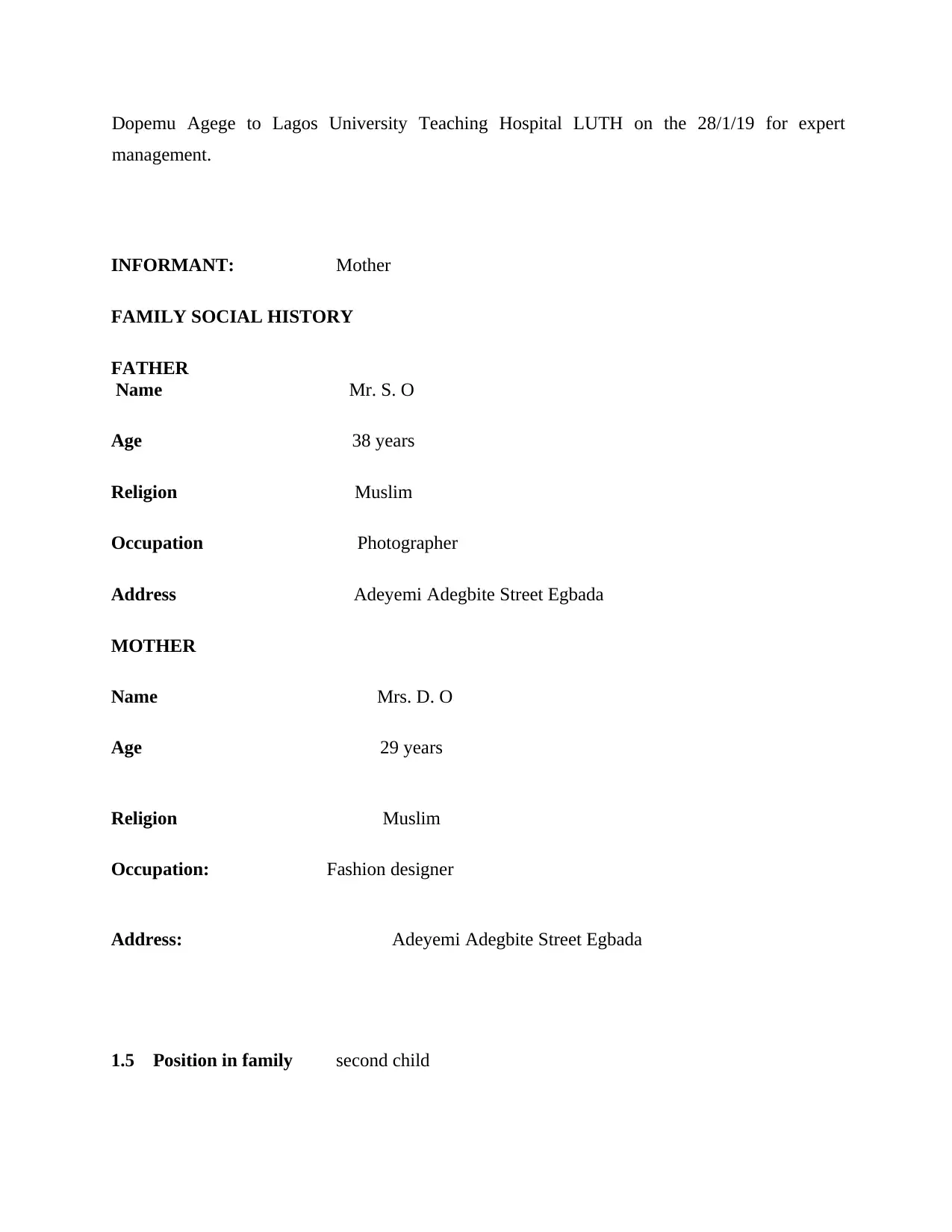
Dopemu Agege to Lagos University Teaching Hospital LUTH on the 28/1/19 for expert
management.
INFORMANT: Mother
FAMILY SOCIAL HISTORY
FATHER
Name Mr. S. O
Age 38 years
Religion Muslim
Occupation Photographer
Address Adeyemi Adegbite Street Egbada
MOTHER
Name Mrs. D. O
Age 29 years
Religion Muslim
Occupation: Fashion designer
Address: Adeyemi Adegbite Street Egbada
1.5 Position in family second child
management.
INFORMANT: Mother
FAMILY SOCIAL HISTORY
FATHER
Name Mr. S. O
Age 38 years
Religion Muslim
Occupation Photographer
Address Adeyemi Adegbite Street Egbada
MOTHER
Name Mrs. D. O
Age 29 years
Religion Muslim
Occupation: Fashion designer
Address: Adeyemi Adegbite Street Egbada
1.5 Position in family second child
⊘ This is a preview!⊘
Do you want full access?
Subscribe today to unlock all pages.

Trusted by 1+ million students worldwide
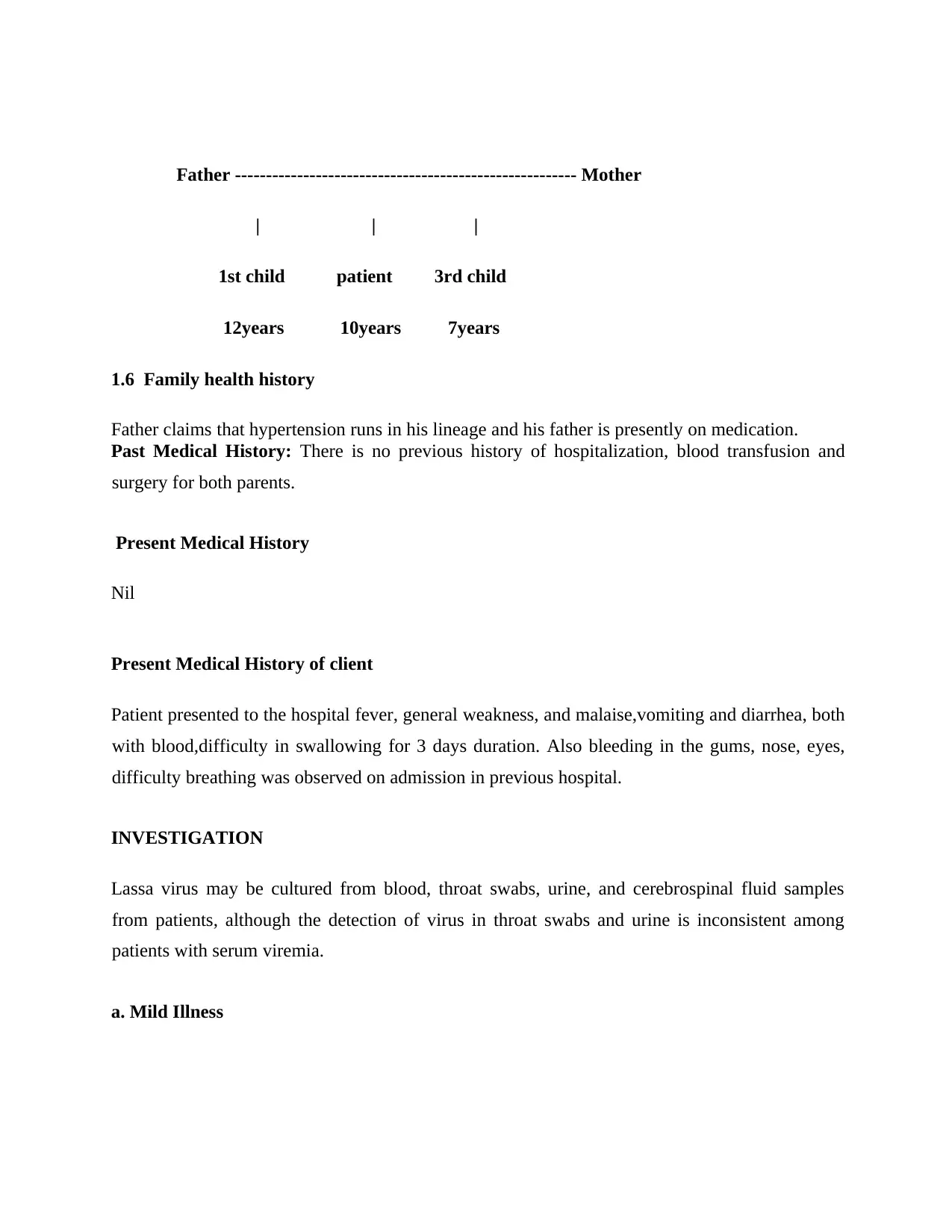
Father -----‐------------------------------------------------- Mother
| | |
1st child patient 3rd child
12years 10years 7years
1.6 Family health history
Father claims that hypertension runs in his lineage and his father is presently on medication.
Past Medical History: There is no previous history of hospitalization, blood transfusion and
surgery for both parents.
Present Medical History
Nil
Present Medical History of client
Patient presented to the hospital fever, general weakness, and malaise,vomiting and diarrhea, both
with blood,difficulty in swallowing for 3 days duration. Also bleeding in the gums, nose, eyes,
difficulty breathing was observed on admission in previous hospital.
INVESTIGATION
Lassa virus may be cultured from blood, throat swabs, urine, and cerebrospinal fluid samples
from patients, although the detection of virus in throat swabs and urine is inconsistent among
patients with serum viremia.
a. Mild Illness
| | |
1st child patient 3rd child
12years 10years 7years
1.6 Family health history
Father claims that hypertension runs in his lineage and his father is presently on medication.
Past Medical History: There is no previous history of hospitalization, blood transfusion and
surgery for both parents.
Present Medical History
Nil
Present Medical History of client
Patient presented to the hospital fever, general weakness, and malaise,vomiting and diarrhea, both
with blood,difficulty in swallowing for 3 days duration. Also bleeding in the gums, nose, eyes,
difficulty breathing was observed on admission in previous hospital.
INVESTIGATION
Lassa virus may be cultured from blood, throat swabs, urine, and cerebrospinal fluid samples
from patients, although the detection of virus in throat swabs and urine is inconsistent among
patients with serum viremia.
a. Mild Illness
Paraphrase This Document
Need a fresh take? Get an instant paraphrase of this document with our AI Paraphraser
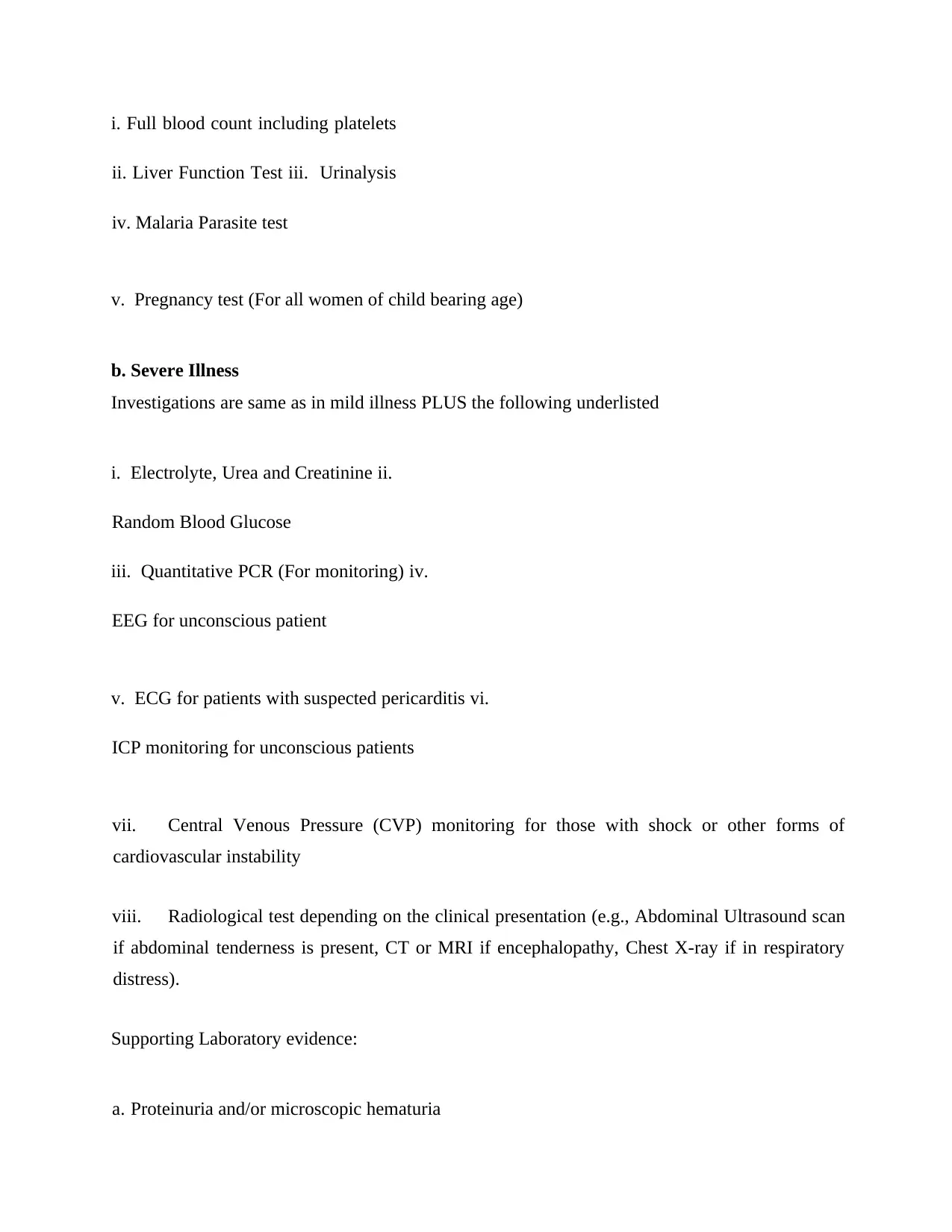
i. Full blood count including platelets
ii. Liver Function Test iii. Urinalysis
iv. Malaria Parasite test
v. Pregnancy test (For all women of child bearing age)
b. Severe Illness
Investigations are same as in mild illness PLUS the following underlisted
i. Electrolyte, Urea and Creatinine ii.
Random Blood Glucose
iii. Quantitative PCR (For monitoring) iv.
EEG for unconscious patient
v. ECG for patients with suspected pericarditis vi.
ICP monitoring for unconscious patients
vii. Central Venous Pressure (CVP) monitoring for those with shock or other forms of
cardiovascular instability
viii. Radiological test depending on the clinical presentation (e.g., Abdominal Ultrasound scan
if abdominal tenderness is present, CT or MRI if encephalopathy, Chest X-ray if in respiratory
distress).
Supporting Laboratory evidence:
a. Proteinuria and/or microscopic hematuria
ii. Liver Function Test iii. Urinalysis
iv. Malaria Parasite test
v. Pregnancy test (For all women of child bearing age)
b. Severe Illness
Investigations are same as in mild illness PLUS the following underlisted
i. Electrolyte, Urea and Creatinine ii.
Random Blood Glucose
iii. Quantitative PCR (For monitoring) iv.
EEG for unconscious patient
v. ECG for patients with suspected pericarditis vi.
ICP monitoring for unconscious patients
vii. Central Venous Pressure (CVP) monitoring for those with shock or other forms of
cardiovascular instability
viii. Radiological test depending on the clinical presentation (e.g., Abdominal Ultrasound scan
if abdominal tenderness is present, CT or MRI if encephalopathy, Chest X-ray if in respiratory
distress).
Supporting Laboratory evidence:
a. Proteinuria and/or microscopic hematuria
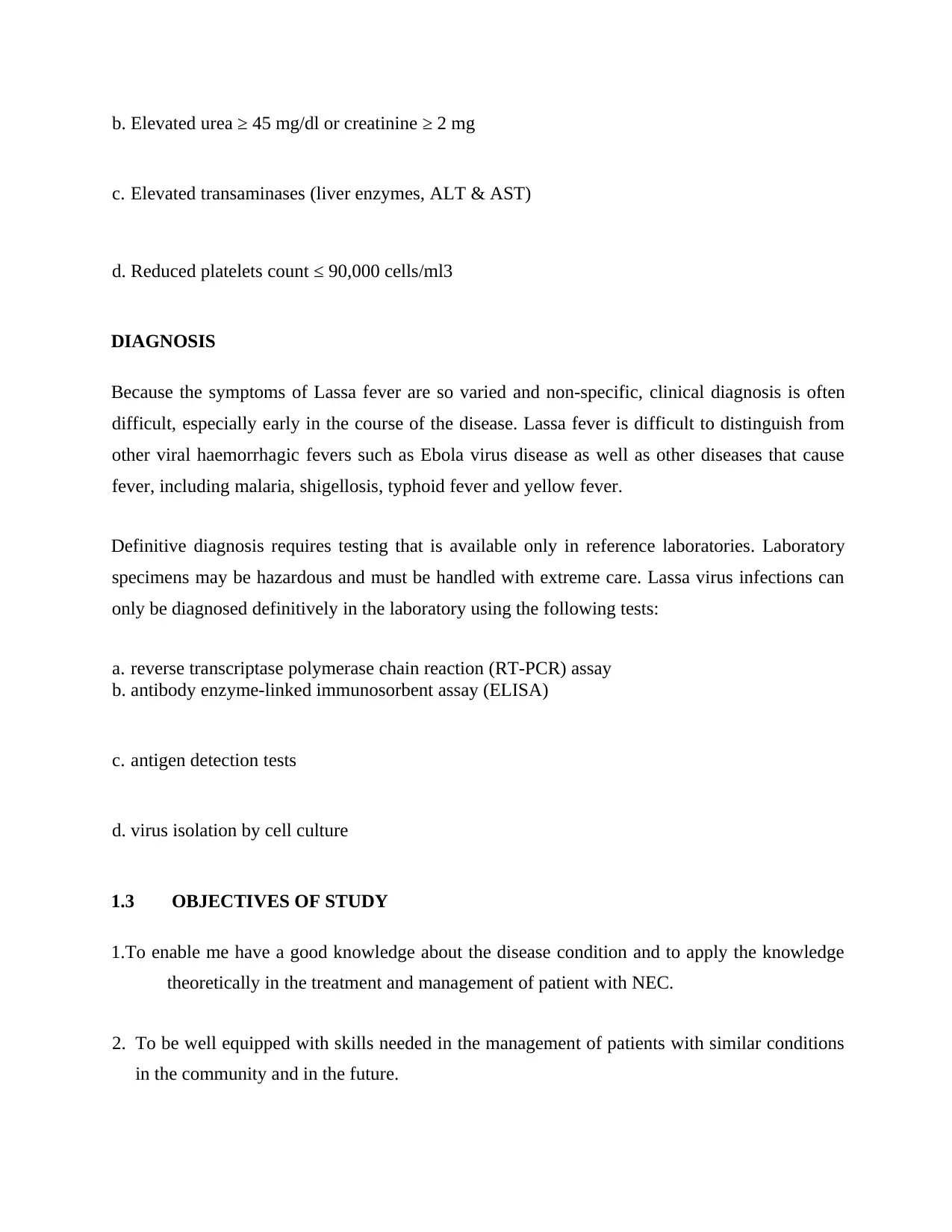
b. Elevated urea ≥ 45 mg/dl or creatinine ≥ 2 mg
c. Elevated transaminases (liver enzymes, ALT & AST)
d. Reduced platelets count ≤ 90,000 cells/ml3
DIAGNOSIS
Because the symptoms of Lassa fever are so varied and non-specific, clinical diagnosis is often
difficult, especially early in the course of the disease. Lassa fever is difficult to distinguish from
other viral haemorrhagic fevers such as Ebola virus disease as well as other diseases that cause
fever, including malaria, shigellosis, typhoid fever and yellow fever.
Definitive diagnosis requires testing that is available only in reference laboratories. Laboratory
specimens may be hazardous and must be handled with extreme care. Lassa virus infections can
only be diagnosed definitively in the laboratory using the following tests:
a. reverse transcriptase polymerase chain reaction (RT-PCR) assay
b. antibody enzyme-linked immunosorbent assay (ELISA)
c. antigen detection tests
d. virus isolation by cell culture
1.3 OBJECTIVES OF STUDY
1.To enable me have a good knowledge about the disease condition and to apply the knowledge
theoretically in the treatment and management of patient with NEC.
2. To be well equipped with skills needed in the management of patients with similar conditions
in the community and in the future.
c. Elevated transaminases (liver enzymes, ALT & AST)
d. Reduced platelets count ≤ 90,000 cells/ml3
DIAGNOSIS
Because the symptoms of Lassa fever are so varied and non-specific, clinical diagnosis is often
difficult, especially early in the course of the disease. Lassa fever is difficult to distinguish from
other viral haemorrhagic fevers such as Ebola virus disease as well as other diseases that cause
fever, including malaria, shigellosis, typhoid fever and yellow fever.
Definitive diagnosis requires testing that is available only in reference laboratories. Laboratory
specimens may be hazardous and must be handled with extreme care. Lassa virus infections can
only be diagnosed definitively in the laboratory using the following tests:
a. reverse transcriptase polymerase chain reaction (RT-PCR) assay
b. antibody enzyme-linked immunosorbent assay (ELISA)
c. antigen detection tests
d. virus isolation by cell culture
1.3 OBJECTIVES OF STUDY
1.To enable me have a good knowledge about the disease condition and to apply the knowledge
theoretically in the treatment and management of patient with NEC.
2. To be well equipped with skills needed in the management of patients with similar conditions
in the community and in the future.
⊘ This is a preview!⊘
Do you want full access?
Subscribe today to unlock all pages.

Trusted by 1+ million students worldwide
1 out of 39
Your All-in-One AI-Powered Toolkit for Academic Success.
+13062052269
info@desklib.com
Available 24*7 on WhatsApp / Email
![[object Object]](/_next/static/media/star-bottom.7253800d.svg)
Unlock your academic potential
Copyright © 2020–2025 A2Z Services. All Rights Reserved. Developed and managed by ZUCOL.